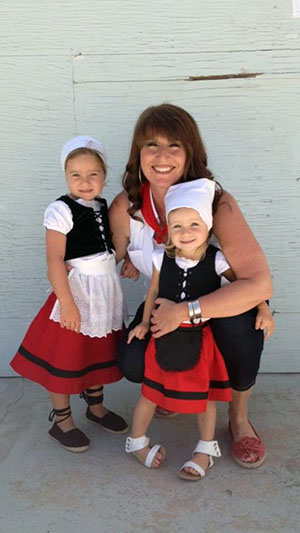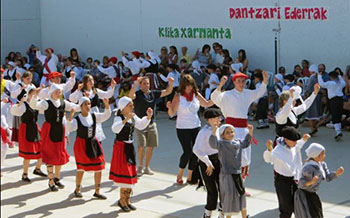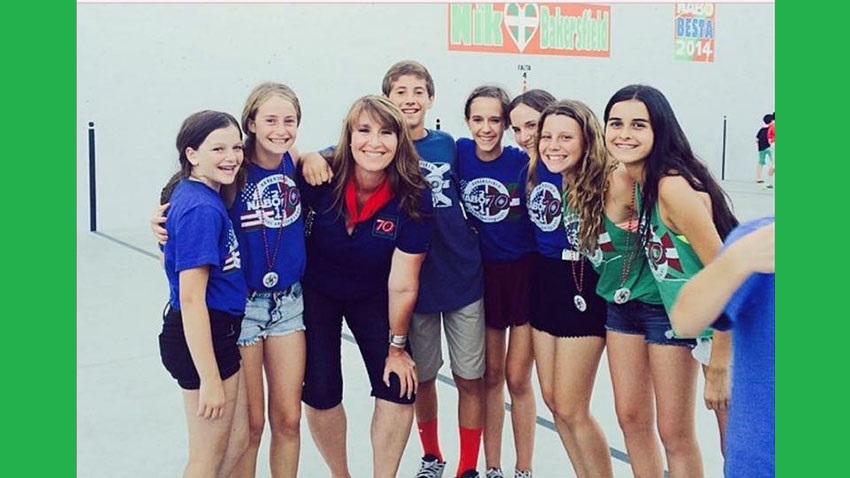Ander Egiluz Beramendi, USA. Surrounded by kids, friends, and Basque music, Kristie Onaindia is the life of the party, but in real life she’s quite shy. “I’m not good at this,” said she, before the interview. “There are a lot of dance instructors that have done much more than me.” She doesn’t seem to feel very comfortable as an interviewee, but after 23 years of volunteering it’s a necessary step.
After more than two decades teaching Basque dances at the KCBC, you’ve decided to stop. Is it an intermission or a definite finish?
-It’s not an intermission, I’m done teaching. I’ve loved each and every single year I’ve been an instructor but I think it’s time for a change and for new blood. I also have a bad knee and, I know it sounds funny, but I had to take two Advils after each practice! (She laughs) I turned 40 this years and I definitely feel tired.
You are a very beloved and charismatic person, it’s not going to be easy to fill that gap for the Club.
-Thanks a lot! That’s very nice. The Club still has a group of great instructors that I know will do a great job: Josette Daramy, Michelle Bochoz, John Goyenetche, Patric Camou, and Nikki Iturriria. We need a lot of people because we have over a hundred kids.
Twenty years is a long time. Have things changed when it comes to teaching dances?
-Oh, yes! Just to give you an example, at the beginning, I used to go to Jeannette Harryet’s house, because she knew how to play the accordion. So she used to play the music for me, I had to record it, bring it to the Club and teach the dances with the music from Jeannette’s house. Now John (Goyenetche) sends me the music via email.
Jeannette Harryet was an important woman in your life but, who introduced you to Basque dances?
-Jeannette taught me a lot when I was a kid but it was my amatxi (grandmother) [Catherine Ermigarat Ansolabehere] who taught me dancing when I was little. She made me love dances. She always picked me up and she always had Basque music in the car. When I was little, I got chickenpox and she started teaching me the dances at home.
Was it through these dances that you became interested in your origins?
-Totally! I loved them and I learnt who I was, where I came from through the dances. Also, my parents (Jesus Onaindia and Mary Lu Ansolabehere) were in the Board of Directors (of the Club), so I became part of the Club too.
You’ve been to the Basque Country several times. Would you say that a dance instructor of a Basque American community is more than ‘just’ a teacher? Is she/he also a bridge between the two worlds?
-I hope so. And I think it’s the same with the Klika and Pilota instructors. At the Picnic, I don’t really care if the kids mess up, my goal is not just to make them look good but to make them love the Club and have fun. Dancing is their way to be in touch with their origins. You know you did a good job when it’s night and they still dance. They don’t have to, but they do it.
-Do kids’ instructors need to have a special gift?
Well, honestly, I think I’m still a kid in some way (she laughs). You have to like to be around them and I love it. You become friends with them and, every Sunday, after practice, I look forward to seeing them next week.
 As a folk dance instructor, did you try to keep the traditions while also making Basque dances evolve in a Basque-American way?
As a folk dance instructor, did you try to keep the traditions while also making Basque dances evolve in a Basque-American way?
-I never did that, I always stuck to the traditional way because I love it. It’s traditional but it’s fun and with fun it always works.
In the Bakersfield Besta of 2013, the dance groups ended their performance with ‘Gangnam Style,’ the choreography of that year’s radio-hit.
-(She laughs) That is John (Goyenetche), he is good at that. We like to do something silly at the end but those are his ideas. That’s why it’s good that he’s going to be there.
Are you proud with what you have achieved as an instructor?
-Yes I am. And I’m also very proud of all the kids. In some practices, especially before the picnic, you think, “oh my! They look like…,” but, then, they always do a great job. I would like to see that they stay involved with the Club and the Basque culture. It doesn’t matter whether it’s through dancing, volunteering at a fair, going to Basque events… It's good for them to stay close to Basque friends because they are your true friends, for the good times and the bad times. I feel proud to be Basque and I think I’m a lucky person for that, and that’s what I want the kids to feel too. That the Basque Club is an extended family.







 As a folk dance instructor, did you try to keep the traditions while also making Basque dances evolve in a Basque-American way?
As a folk dance instructor, did you try to keep the traditions while also making Basque dances evolve in a Basque-American way? Send to a friend
Send to a friend Add comment
Add comment








